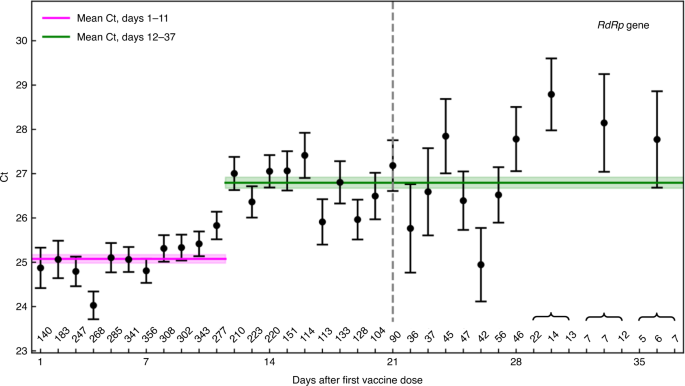The results show that infections occurring 12 d or longer after vaccination have significantly reduced viral loads at the time of testing, potentially affecting viral shedding and contagiousness as well as the severity of the disease
13. This report is based on an observational study, not a randomized controlled trial, and has several associated limitations. First, the group of vaccinees might differ from the demographically matched control group in ways that could affect the observed viral load, such as behavior, tendency to get tested and general health status. Second, the different viral variants, which could be associated with different viral loads, might affect different parts of the population. Third, by including only the first positive test for each patient, we attempted to minimize the effect of long-term, low-viral-load infections, but it is still possible that the association we observed, especially in the early post-vaccination days, reflects infections lasting from pre-immunization transmission events
9,
10,
11,
12. The average viral load might, therefore, continue to change in longer post-vaccination times, when infections are more strongly enriched for post-immunization transmissions, or due to change in vaccinee behavior, especially upon obtaining a vaccination certificate. Fourth, given that vaccines prevent symptomatic disease, post-vaccination tests might be enriched for cases of asymptomatic carriage characterized by lower viral load, although we note that the association of vaccination with low viral load remains even when adjusting for symptomatic disease (Extended Data Fig.
7). Finally, the oro-nasopharyngeal test does not distinguish the viral load in the nose from the one in the oral cavity and does not account for virus viability, which would be a better measure of potential infectiousness. Moreover, the infectious dose of SARS-CoV-2 in humans is presently unknown. The accumulation of wider and longer-term datasets, including contact tracing data as well as virus viability and genomics, will allow better quantification of the vaccine effect on infectiousness and its dependence on viral variants and vaccinee behavior. Nevertheless, at least for the conditions tested here, the lower viral loads that we observed could help fine-tune epidemiological models of vaccine effect on the spread of the virus.











